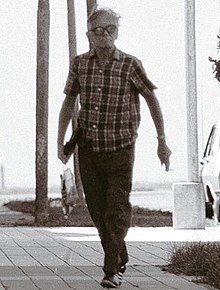Walter Kutschmann

Walter Kutschmann (born May 24, 1914 in Dresden ; † August 30, 1986 in Buenos Aires ) was a German detective commissioner who, as SS-Untersturmführer, carried out several mass shootings in eastern Galicia and the Ukraine .
Career
Walter Kutschmann was born the son of a dentist. He went to high school, which he left without a certificate of maturity. In 1932 he took at a predecessor of the Air Force the service and remained there until 1936. In 1937 he took the Abitur and began to study law, but he broke off soon to be in Spanish Morocco in a legion of Francisco Franco to serve. Later he was secretary at the German consulate in Cadiz .
At the beginning of March 1939, Kutschmann came to the Leipzig State Police Station . He joined the NSDAP soon after the start of the Second World War in February 1940 and the SS in the same month (February 11, 1940) .
Wartime
As a detective inspector with the rank of SS-Untersturmführer , Kutschmann came to Lviv at the end of June 1941 after the attack on the Soviet Union with a command from the commander of the security police . Kutschmann led the firing squad in the Lviv professor murder . Until March 1942, he headed the Gestapo office in Drohobych and then the field service in Tarnopol , where he was involved in further mass shootings.
In 1943 he was sent to the German-occupied France in Hendaye , where he was posted to the border police station on the Spanish border. He was the contact person for Coco Chanel , who worked with the Germans. After the Allies landed in France, Kutschmann deserted to Spain in the summer of 1944 and found shelter with the Carmelites in Madrid .
post war period
At the end of May 1947, Kutschmann had a false Spanish passport issued in the name of Pedro Ricardo Olmo Andres . In mid-January 1948 he left for Argentina , where he received support from the Carmelites and the Peron government . He acquired Argentine citizenship in 1950. At first he made his living as a taxi entrepreneur and from 1958 as sales manager for Osram in Buenos Aires. Under his new name, he remarried his wife in 1962, who took on his new name.
After the end of the war, an arrest warrant was issued against him in Poland because of his main culprit for the Lviv professor's murder and the suspicion of having been involved in the 1942 murder of thousands of Jews in Brzezany and Podhajce . In this context, he is said to have headed a commando in the vicinity of his Drohobych office in 1941, which shot around 65 Jews within two days.
In the course of the trial against Hans Krüger , who protested against the perpetrators of the Lviv professor murder, the public prosecutor's office started investigations against Kutschmann. However, the investigation was closed because the prosecutor believed that the perpetrators had already died. Finally, the Nazi hunter Simon Wiesenthal stepped in , who questioned the Polish Countess Karolina Lanckorońska about the case in Rome . Lanckorońska had also met Krüger's subordinate Kutschmann while in Gestapo detention. Wiesenthal initially looked unsuccessfully for traces of Kutschmann in Spain. Finally, he later received information from friends about a poor Spanish-speaking businessman in Buenos Aires, about whose past nothing was known before 1947. He asked an Argentine journalist to interview Olmo and take pictures of him. Wiesenthal compared these current pictures with old pictures by Kutschmann and unequivocally established his identity. In August 1967 he obtained an arrest warrant against Kutschmann-Olmo from the Berlin Regional Court . However, the Federal Ministry of Justice did not submit an extradition request because, under the Basic Law, Germans were not allowed to be extradited abroad and Argentina insisted on reciprocity. Despite further evidence presented by Wiesenthal in April 1975 that incriminated Kutschmann-Olmo, the Federal Republic did not apply for extradition. Only after Poland reported with new documents in early June 1975 that Theodor Oberländer had been unjustly accused of participating in the murders in Lemberg, Wiesenthal went public with the actual perpetrator, Kutschmann-Olmo. In June 1975 he was arrested by the Argentine Federal Police in Buenos Aires because Argentine newspapers had published Olmo's true identity and the allegations against him. In the interrogations that followed, he denied the allegations made against him. Instead, he stated that, as a native of Spain, he had served in the Wehrmacht during the war, but that he was not identical to the coachman he was looking for. Due to his poor knowledge of Spanish, the suspicious interrogators turned to the German embassy for information on the German search and the results of the investigation. Because the German embassy reacted only days later and an international search request arrived too late in Buenos Aires, the Argentine federal police had already released Kutschmann-Olmo from custody. Kutschmann-Olmo died on August 30, 1986 before he could be extradited to the Federal Republic.
literature
- Stefan Klemp : Concentration camp doctor Aribert Heim. The history of a manhunt , Prospero Verlag, Münster / Berlin 2010, ISBN 978-3-941688-09-4 , pp. 149ff.
- Thomas Sandkühler : “Final Solution” in Galicia - The murder of Jews in Eastern Poland and the rescue initiatives of Berthold Beitz, 1941–1944. Bonn 1996, ISBN 3-8012-5022-9 (short biography p. 441).
Web links
- DER SPIEGEL 28/1975 War Criminals: Long gone
| personal data | |
|---|---|
| SURNAME | Kutschmann, Walter |
| BRIEF DESCRIPTION | German detective commissioner, SS leader and perpetrator of the Holocaust |
| DATE OF BIRTH | May 24, 1914 |
| PLACE OF BIRTH | Dresden |
| DATE OF DEATH | August 30, 1986 |
| Place of death | Buenos Aires |